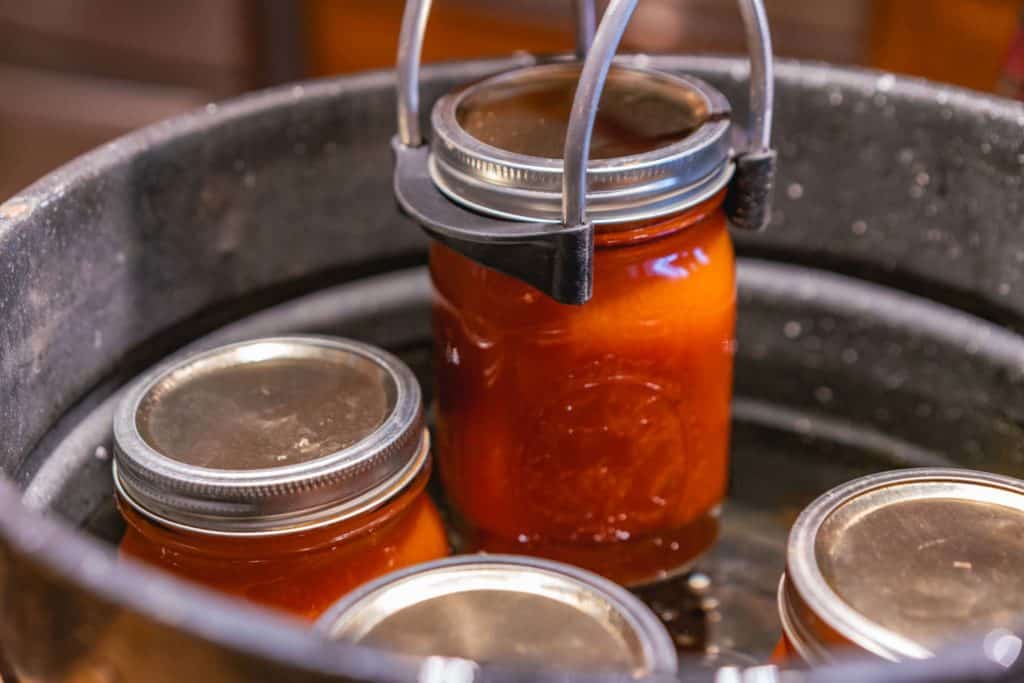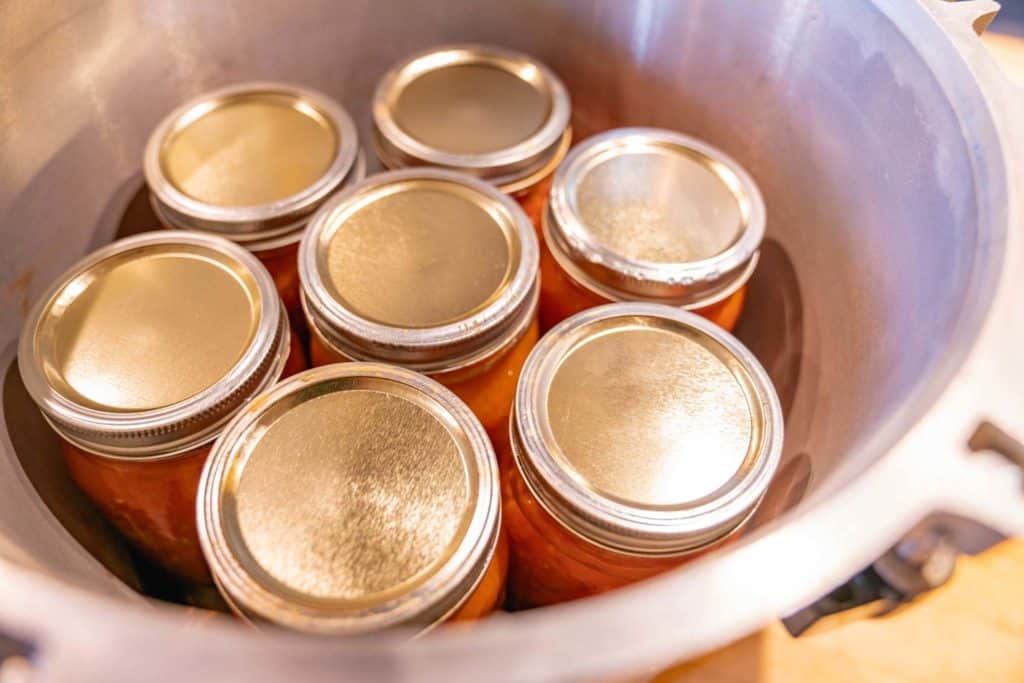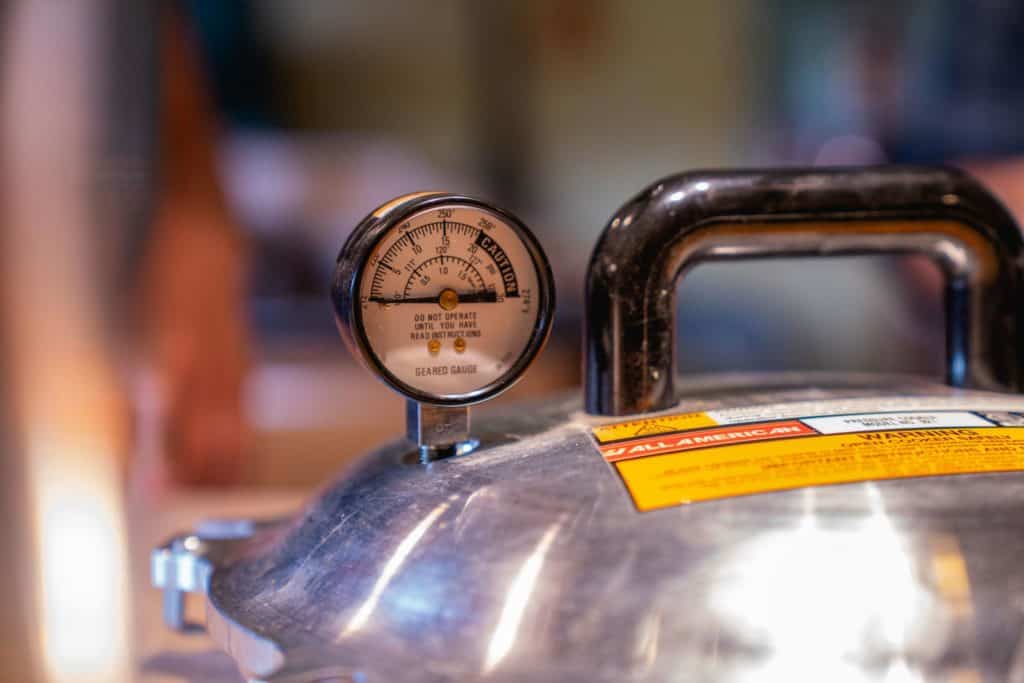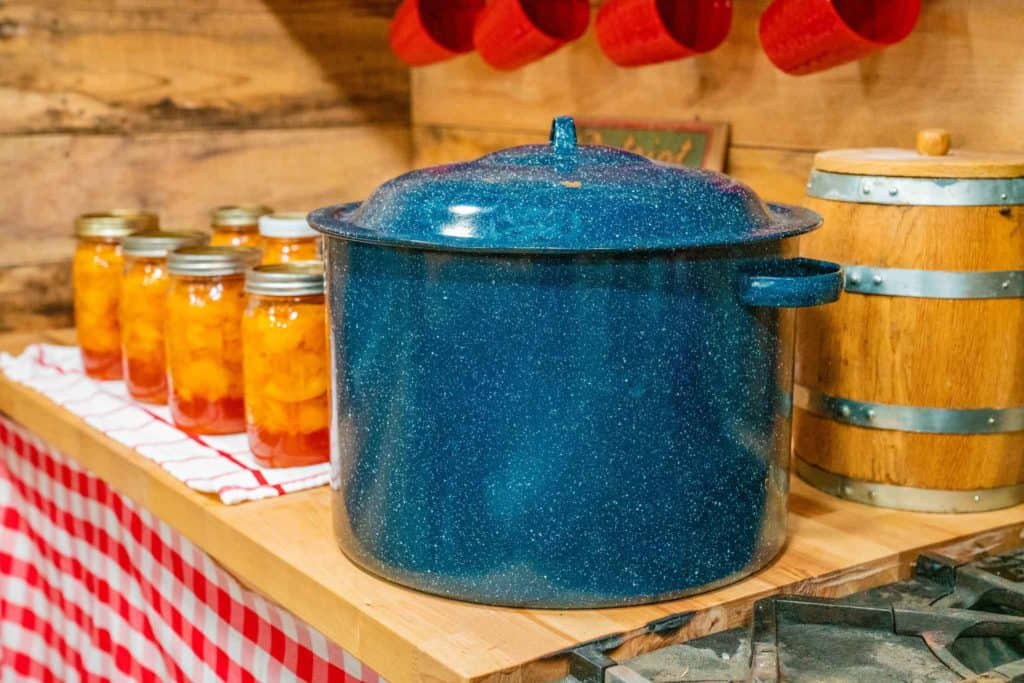Did you know that, according to the CDC, there are about 110 reported cases of botulism annually that are attributed to home canned foods? (Source) Whether you’re new to canning or have been doing it for years, following safety precautions is key. Use this guide to understand common canning mistakes that can kill you and keep your family safe this canning season.

Table of Contents
ToggleWhy You Should Avoid These Canning Mistakes
Each year as I get ready for the preservation season, I get questions like:
- Can I pressure can in the Instant Pot?
- Can you reuse canning lids?
- How full should my pressure canner be when I’m canning?
- What foods should not be canned?
- How long is canned food good for?
While these questions are consistently asked, the most common concern I hear is that you could make a canning mistake that can kill you.
However, when you understand the basics of canning and follow proper canning safety rules, you can rest assured that you can safely can at home.
Let’s take a look at canning mistakes to avoid so you stay safe and don’t lose any of the hard work you did to feed your family healthy, nutritious, homegrown food!

Canning Mistakes That Can Kill You
In the canning world, there is a term called the “lethal rate,” which measures how well canning kills bad microbes in food. It shows how long it takes for canning to kill these germs, which is critical in keeping our food safe.
Scientists use data and math to determine the lethal rate by examining elements like temperature and the type of food, which helps them determine the best way to kill germs.
This science is used to create the gold standard for safe canning practices, and while this handy chart covers the most common canning mistakes that can kill you, home canners should always stay up to date on new information as it becomes available.

| Canning Mistake | Potential Risk | Prevention Method |
| Using Unreliable Recipes | Food spoilage, botulism. | NEVER make up your own canning recipe. Only follow trusted, scientifically tested recipes. |
| Improper Sterilization | Botulism, food contamination. | Sterilize jars and tools by boiling when using a water bath canner or use a pressure canner. |
| Modifying Starch | Prevents proper heat penetration and can result in undercooked foods. | Don’t modify the starch in tested recipes; always use the called-for amounts. |
| Processing on a glass stovetop | Not all glass stovetops can support the weight of the canner or the heat needed for canning, causing the glass on the stovetop to break. | Before canning on a glass stovetop, check with the manufacturer to make sure the appliance is rated for canning, and that your canner is no larger than one inch wider than the burner. |
| Using the oven method | Air is not a sufficient conductor of heat, leaving foods under-processed. This method can also cause jars to break or explode. | Use canners designed specifically for the job such as water bath canners or pressure canners. |
| Using an Instant Pot to pressure can | Instant Pots and multicookers are not properly calibrated for safe canning. | Leave the Instant Pot for cooking and use a USDA approved pressure canner for canning. |
| Neglecting altitude adjustments | Boiling temperatures differ according to altitude. Higher altitudes require more pounds of pressure for pressure canning, and water bath canning requires extended processing time. | Know your altitude and adjust processing times accordingly. |
| Neglecting a proper seal | Improper seals can result from neglecting to wipe the rims of the jars before fastening the lid, and can cause food siphoning from overfilled jars or vacuuming from underfilled jars (including jars without air bubbles removed). | Always fill jars following the recommended headspace, and use a plastic headspace ruler or wooden skewer to shift the foods on all four sides of the jar, releasing air bubbles prior to processing. Do not use a metal utensil as it will damage your jars, causing weak points prone to breakage. Before adding the lid, always wipe the rim with a clean, lint-free towel (or paper towel) dipped in vinegar of at least 5% acidity. |
| Over-tightening lids | If your bands are too tight, air will not properly vent from the jars, causing the lids to buckle and resulting in seal failure. | Screw on the bands “finger-tip-tight,” meaning that you only use the tips of your fingers (not the palm of your hand) just until you reach the point of resistance. |
| Neglecting to vent the canner | Venting distributes the heat evenly. Without it, the temperature will not reach the optimal temperature for safe processing. | Your pressure canner needs to steam for a solid 10 minutes BEFORE you put that canning gauge on. Implementing this step has diminished the number of botulism cases drastically. |
| Neglecting to have your gauge tested | Untested gauges are untrustworthy and produce inconsistent results. | Have your dial gauge tested annually at your local extension office. The workaround to getting your pressure gauge tested would be to use a weighted gauge pressure canner. This means your jiggler or weight determines the pressure and not a dial gauge. |
| Neglecting to add acid to low acid foods (like tomato products) | Foods such as tomatoes generally do not have a high enough acid level to prevent botulism from growing. | Follow approved recipes, and do not skip or reduce the acid ingredients. |
| Attempting to speed up cooling time | Approved recipes depend on cool-down time as part of the cooking process. If this is sped up, the foods will be underprocessed, leading to potential botulism growth. | Water Bath Method: Turn the heat off, remove the water bath canner lid, and let the jars sit for 5 minutes. Pressure Canner Method: Once the pressure has dropped back down to zero naturally, remove the canner lid and let the jars sit for 5 minutes before removing the jars. NEVER run your hot canner under water. This could additionally cause jars to break. Place hot jars on a towel to cool for 16 to 24 hours undisturbed. |
| Allowing “hot pack” foods to cool | Hot pack processing relies on the food to remain hot. If the hot pack items cool between steps, they will be undercooked and prone to botulism growth. | Move quickly, and work in batches to keep hot pack items at the right temperature before processing in the canner. |
| Neglecting to remove bands prior to storage. | Leaving the bands on can create a “false seal,” preventing you from properly inspecting your preserves before storing them. | Remove bands once your jars have cooled. If you have space, it’s recommended to store your jars in a single layer. However, if you need to stack jars for space reasons, just be sure you put something like a layer of cardboard in between the jars so the weight of the jar is not on the center of that lower jar lid causing a potential false seal. |
| Substituting fresh lemon juice for bottled | Bottled lemon juice provides a consistent acid level suitable for safe canning, whereas fresh lemons vary in their acidity levels. | Always use bottled lemon juice unless an approved canning recipe specifically instructs to use fresh lemon juice. In this case, the recipe is relying on lemon juice for flavor instead of acid. |
| Improper ratios of vegetables in salsas | Increasing onions, peppers, or other vegetables can throw off the acidity ratio resulting in possible botulism poisoning. | Follow the exact measurements indicated in the approved recipes. |

Abundant Pantry Canning Masterclass
Now that you are equipped with the knowledge of canning mistakes that can kill you, don’t miss my pressure canning tips to take your canning game to the next level.
If you’re ready to become a home canning master, check out my class, The Abundant Pantry: Canning Masterclass. In this online course, you will learn:
- How to fill your pantry with healthy, SAFE canned foods.
- Create a stash of delicious convenience foods, ready to heat and eat!
- Save $$$ buying in season and preserving for use all year.
- Avoid allergens by knowing exactly what is in every jar.
- Make all-fruit jams with no added sugar.
- Can SAFE sauces and soups in your water bath canner.
- Fill the cupboard with tender, flavorful meats for quick and easy use.
- Fearlessly use your pressure canner to create family-favorite meals.
- Know the science behind SAFE canning so you can confidently serve your friends and family great meals from a jar.
With over 20 step-by-step video tutorials, The Abundant Pantry: Canning Masterclass will take you from “Never Canned Before” to “Canning Master” in just days! Sign up to receive instant access, and start today!

FAQ
Proper canning prevents harmful bacteria from growing in food, keeping people safe from deadly illnesses like botulism poisoning. Always follow safety tips and guides to keep food safe.
Risks include botulism from bad canning, contamination, and spoilage. To stay safe, follow trusted and approved guides and precautions carefully.
Mistakes include not sterilizing jars and using untested recipes. These mistakes can make food unsafe and cause health problems. Always be careful and follow safe methods.
Use tested recipes and follow the recommended times. The wrong times can spoil food or make you sick. Always follow the best practices.
A bad pressure canner can’t kill bacteria. It’s important to check and keep your canner in good shape. This keeps your food safe.
A good seal keeps air and bacteria out. Without it, food can spoil and be dangerous. Always make sure to seal your jars well.
Botulism is hard to spot by taste, smell, or sight. Look for bulging lids and leaks. Knowing these signs is key to staying safe.
Use proper canning techniques to kill botulism spores. Safe canning is key to avoiding contamination.
The lethal rate is the time and temperature to kill bacteria. Knowing this is crucial for safe canning.
Home canning lets you control ingredients and avoid additives. But, you must follow safety rules carefully. Commercial food is safe but may have additives. Comparing these helps you choose wisely.
Tested recipes use the right times and methods. They help avoid dangerous risks. We recommend always using recipes from trusted sources.
Water bath canning is for high-acid foods. Pressure canning is for low-acid foods. Mixing methods can be unsafe. Knowing which to use is important for safe canning.



















